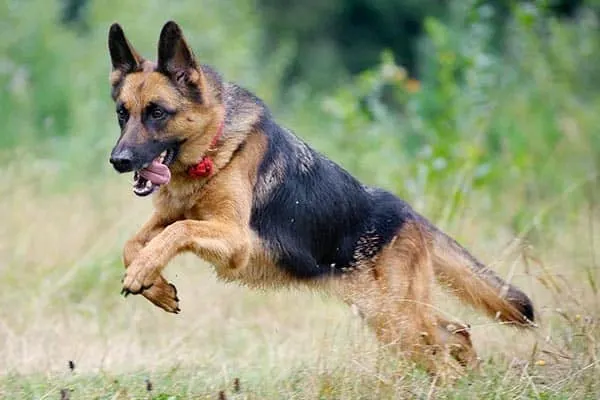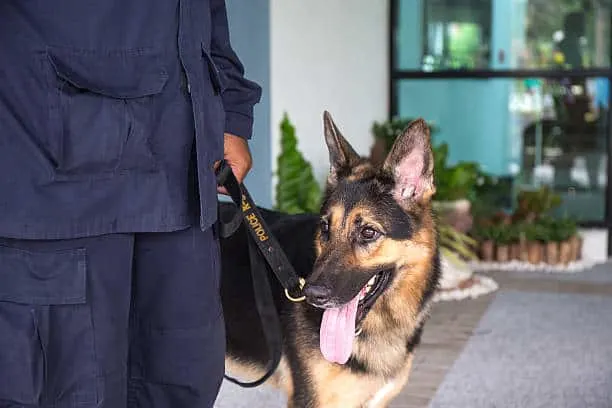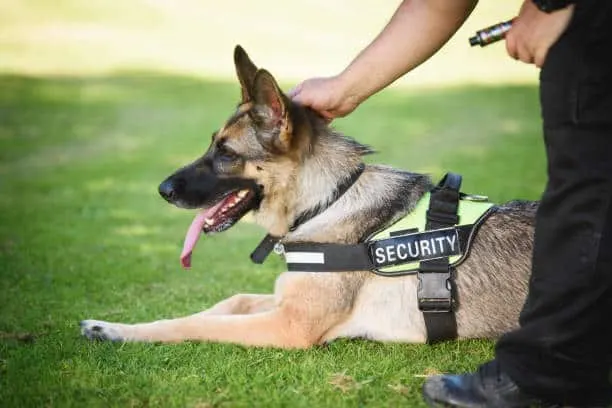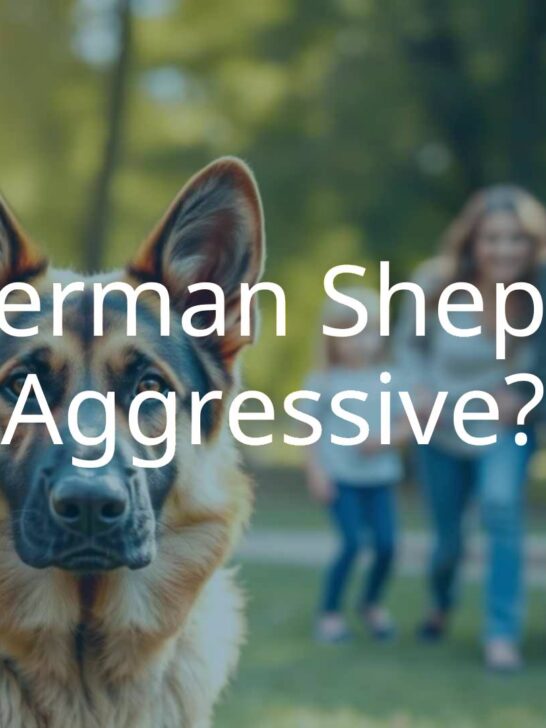What Are German Shepherds Bred For: Learn the Origins Of This Popular Dog Breed
When the American Kennel Club (AKC) releases its annual report of the most popular purebred dog breeds, the German Shepherd is always right near the top of the list.
In fact, out of 195 AKC-registered breeds, the only dog that currently outranks the GSD in popularity is the super-friendly Labrador Retriever!
So it surprises many new German Shepherd owners when they learn that this dog breed wasn’t actually ever supposed to be a family pet.
Nope – these dogs were bred purely to work and to do a very specific type of work at that.
In this article, we will give you an overview of how the German Shepherd dog breed has evolved from its origins in the early 19th century to today.
What Are German Shepherds Bred For?
The very first German Shepherds were being bred back in 1889 by a German officer named Captain Max von Stephanitz.
The good captain wanted to create the perfect working dog breed for use in herding and livestock guarding and military work.
The German Shepherd was his creation and has turned out to be an enduring popular working dog breed that has far exceeded his initial expectations.
Watch an Amazing German Shepherd Training for K-9 Work
If you have never witnessed a professional dog trainer put a new German Shepherd K-9 training candidate through their paces, you are in for a jaw-dropping treat with this YouTube video clip.
This amazing video allows you to watch a German Shepherd flawlessly executing command after command in preparation to serve as a guarding and protection dog.
What Kind of Work Do German Shepherd Dogs Do Today?
Of course, as the American Kennel Club (AKC) points out, it has been a long time since dogs were in high demand to work in livestock herding and guarding.
In fact, as the first World War began in 1914, von Stephanitz’s dog became a prime choice to serve as a military K-9.
From the start, the traits von Stephanitz had bred for made the German Shepherd an ideal canine candidate for service.
The German Shepherd was courageous, loyal, strong, and athletic, with high pain tolerance and intense focus when there was a job to do.
The Military Working Dog Team Support Association (MWDTSA) states that the German Shepherd’s main duties were as guard and sentry, messenger dog, and aid to wounded soldiers.
In fact, GSDs were so good at leading wounded soldiers off the battlefield they became the prototype for a new canine role that had yet to be created – guide dog to the blind.
While at first the whole introduction of dogs into military service was viewed with amusement or tolerance by some, the German Shepherd performed so admirably and nobly that by the time the war ended, military dogs were in training around the world.
When World War II erupted in 1939, the German Shepherds were pressed into service yet again and once again performed admirably.
Dogs continued to serve alongside human soldiers in every subsequent major military conflict and continue to do so today.
Some of the most amazing roles performed by military K-9 German Shepherds included mine and detection dogs, sentry dogs, scout or patrol dogs, and messenger dogs.
Today, GSDs also train to perform HALO (high altitude low opening) military parachuting jumps. And they are trained to accompany Navy SEALS on boat missions as well.

Other Working Dog Roles German Shepherds Excel In
While the first roles that German Shepherd dogs were in demand for were primarily livestock ranching and military service, it didn’t take long for people from many different walks of life to take interest in this noble dog breed.
German Shepherd dogs in the cinema
As The New Yorker highlights in their editorial piece “The Dog Star,” Rin Tin Tin was the only the second German Shepherd to grace the silver screen (the first was Strongheart).
This dog’s own life began on a battlefield with a man named Lee Duncan who rescued the blind, skinny, starving, abandoned pup.
His owner was determined to get Rin Tin Tin into the Hollywood film business, and knocked on doors ceaselessly and even created his own screenplay – starring his dog, of course.
Eventually, he got Warner Bros. studios to agree to produce it.
That was the start of German Shepherds in the movie business.
With at least 15 other well-known German Shepherd dogs following in Rin Tin Tin’s footsteps, and countless more today, dogs have since become standard fare in films because they sell tickets!
German Shepherd dogs in competitive K-9 athletics
As the German Shepherd Rescue Elite explains, German Shepherds are quite simply incredible canine athletes.
These dogs have a tireless work ethic, naturally high energy levels, a strong and powerful body, and intelligence that places them in the top-10 tier of all dog breeds, according to Science Alert.
German Shepherds have everything a dog needs to create a superstar athlete, which has made the GSD a top choice for trainers who want to participate in canine athletic competitions.
German Shepherds can readily master a new command in as little as five tries and replicate it with perfect obedience at least 95 percent or greater.
They have an intensely strong need to please their people, which makes them ideal competitors.
German Shepherd canine sports range from Schutzhund to agility, obedience/rally to dock diving, scent and nose work to search and rescue, and much more. German Shepherds are also natural performers in the show ring.
In Germany, there is also a type of canine athletics called HGH (Herdengebrauchshund) that tests the skills of herding and livestock guarding and patrolling dogs.
Naturally, German Shepherd dogs excel in these competitions as well.
German Shepherd dogs in police and personal protection work
Yet another role that was a natural fit for German Shepherds after their stellar service record in military K-9 roles was police and personal protection work.
Today, German Shepherds are still a top pick to work in a wide variety of public police and private protection work for both institutions and individuals, as Anges Gardiens German Shepherd breeder explains.
Examples include German Shepherds working in narcotics and bomb-sniffing, search and rescue and forensics, Secret Service, and on-site guard dog and protection dog duty.

Traits That Make the German Shepherd the Ideal Working Dog Breed
Just as the breed’s founder, Captain Max von Stephanitz, intended, the German Shepherd has a number of traits that make this dog truly a perfect working dog choice.
Loyalty
The German Shepherd’s loyalty is unmatched in the canine world.
Like the German Shepherd Dog Club of the San Gabriel Valley highlights, this is a dog that will go the extra mile to do anything they are asked to do.
Smarts
As we mentioned earlier, in a study of 79 purebred dog breeds as assessed by nearly 200 dog trainers, German Shepherds consistently placed in the top 10 smartest dog breeds for their ability to quickly master new commands and replicate them consistently.
Strength
German Shepherds can easily grow to weigh 50 to 90 pounds and stand up to 26 inches tall (paw pads to shoulders).
These are lean, rangy dogs with long legs that can gather speed and power at an incredible clip. As you saw in the video clip here earlier, once a GSD latches onto your arm, you will definitely know it!
High pain tolerance
As Von Der Otto Kennels points out, German Shepherd breed lines that focus on true working dog traits (versus appearance or show dog traits) typically breed German Shepherds with unusually high pain tolerance.
The reason for this relates to the types of jobs working German Shepherd dogs are bred to do.
With a higher pain tolerance, a German Shepherd in the field can face down attackers or predators and withstand injury if need be to get their job done.
Deep intimidating bark
Anyone who has ever heard the German Shepherd dog’s bark at close range knows this is not a dog that means anything less than pure business.
It is easy to see (and hear) why the GSD has become a top choice for a family guard dog as well.
Large size
The German Shepherd can weigh anywhere from 50 to 90 pounds or even more dependent on the breed line and size of the parent dogs.
These large breed dogs are physically intimidating in every way and designed to intimidate predators both animal and human.
Power and strength
German Shepherds are dogs that can learn to jump out of planes and board boats, run swiftly through battlefields and perform perilous search and rescue missions.
They are bred for power and strength to do jobs even some humans could not attempt to do.
Bravery
German Shepherds are decorated, military heroes.
As the U.S. War Dog Association highlights, German Shepherds continue to be the military’s preferred dog breed because they will perform their jobs well under even the most difficult and dangerous conditions.
Intense focus
A German Shepherd dog that is “on the job” literally has unbreakable concentration.
Intense focus is a hallmark trait of any dog that hails from livestock guarding background since even a moment of lapsed attention could mean a predator can infiltrate the herd.
Bonds closely to trainers
German Shepherds are known to be intensely people-focused dogs that need to be close to people.
The German Shepherd’s ability to bond closely with “their” people is the same trait that can over-ride their other highly-developed aggressive and protective traits to obey commands under extreme duress.
High energy level
German Shepherds have a herding and guarding background – a job with very long hours under often difficult conditions.
Terrain, weather, plus a physically demanding job means only a dog with unstoppable energy could keep the herd safe.
Today’s German Shepherds may not be called upon to guard livestock that frequently, but they excel at many other jobs that require the same levels of unstoppable energy and activity.
Agility
There is no doubt that a German Shepherd is a dog that is born and bred to run, jump, tackle, hurdle, swim, and do anything that the job physically requires.
These dogs are quite simply unparalleled athletes no matter what they are doing.

Keeping a Working Dog Like the GSD As a Companion Canine
One of the foremost challenges for many pet dog owners today is understanding some of the unique needs of different dog breeds in a pet setting.
After all, there are no other species on the planet today that is so diverse as Canis lupus familiaris, the modern domestic dog.
The reason modern dogs are so diverse, as Live Science points out, is because different dog breeds have been deliberately developed for different reasons.
Dachshunds, with their dwarfed legs and stout bodies, were designed to hunt badgers and drag them out of their burrows.
German Shepherds were designed to tackle dangerous predators like bears, coyotes, and wolves on behalf of hundreds or even thousands of livestock animals.
Where it gets challenging to keep a working dog breed as a companion canine is to make sure your dog has the right daily enrichment to fulfill their urges and meet their daily needs.
For example, the German Shepherd has a lot of energy they need to burn off.
As many owners attest, a bored or lonely German Shepherd can become a destructive dog, because these smart dogs will invent their own job if you don’t give them one.
Taking your dog for walks or runs and scheduling several daily sessions of playtime can meet this need so that you don’t experience behavioral issues from your dog.
This way, your German Shepherd will be a healthy and happy companion canine to your family.




















